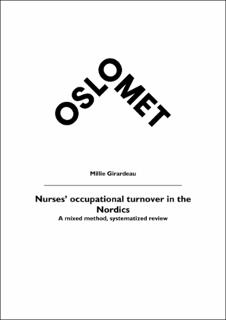| dc.description.abstract | This thesis aims to explore the reasons behind nurses’ occupational turnover in the Nordics to construct an overview of what is known on the subject, identify possible gaps in the knowledge on nurses’ occupational turnover and to identify possible areas for policy action in the Nordic context.
Background: The nurse shortage presents a challenge for public health policy that is found both internationally and in high-income countries. A shortage in nurses has also been identified in the Nordics and is expected to increase in the coming years. Context specific research is needed to develop appropriate policy recommendations to alleviate this issue.
Method: This thesis conducted a mixed method, systematized review of primary studies in the Nordics exploring nurses’ occupational turnover. Searches were performed in: Academic Search Ultimate, Cinahl, Embase, Medline, Oria, Psycinfo and SocIndex. Studies were synthesized with an aggregative thematic analysis.
Results: The systematic search and screening process resulted in 19 studies. This thesis found that research on nurses’ occupational turnover is highly varying in relation to population selection and methods, deeming it difficult to synthesize the studies across findings. However, the thematic analysis in this systematized review identified three main themes connected to nurses’ occupation turnover in the Nordics: nurse characteristics, work-related factors, and personal factors. Of characteristics, findings indicated that young, male, and less experienced nurses have an increased risk of occupational turnover. Work-related aspects of the profession that may play a role in nurses’ occupational turnover were work-family conflict, poor workplace relations, low wage, shift work, low possibilities for development and high job strain (comprising of high job demands and low job control). Personal reasons indicated to play a role in nurses’ occupational turnover was burnout.
Discussion: The findings of possible reasons for occupational turnover may be considered superficial. More research is needed on nurses’ occupational turnover in the Nordic context to provide specific policy recommendations. However, by considering findings through the job-demand control and job demand control support models the argument may be made that nursing falls into the high job strain category. | en_US |
